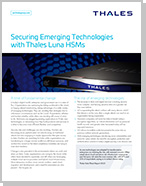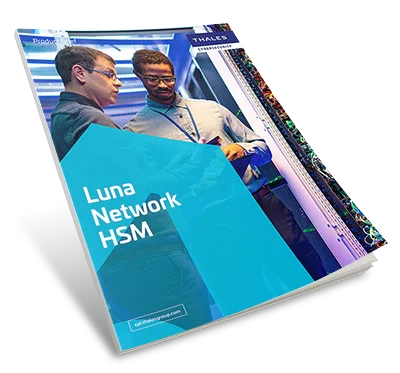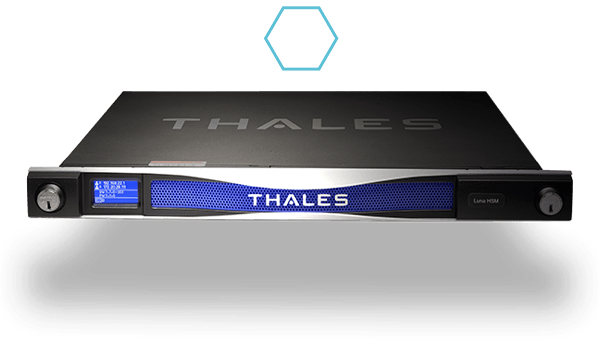TalkingTrust with Thales and Keyfactor – IoT
 In this brief video, you’ll hear from Ellen Boehm, VP of IoT Strategy at Keyfactor, and Dave Madden, Sr. Director of Business Development at Thales, as they discuss the current state of IoT security and share their joint solution for securing the entire IoT ecosystem using Keyfactor Control and Thales Luna HSMs.
In this brief video, you’ll hear from Ellen Boehm, VP of IoT Strategy at Keyfactor, and Dave Madden, Sr. Director of Business Development at Thales, as they discuss the current state of IoT security and share their joint solution for securing the entire IoT ecosystem using Keyfactor Control and Thales Luna HSMs.
In this video, join Thales and Keyfactor as they discuss the current state of IoT security, and share their joint solution for securing the entire IoT ecosystem.
Speakers:
Dave Madden, Director of Business Development at Thales
Ellen Boehm, VP of IoT Strategy at Keyfactor
Review all integrations and supporting documents for Thales with Keyfactor.
Thales Technology Partner: cpl.thalesgroup.com/partners/keyfactor
Partner website: www.keyfactor.com

Resources:
Video Transcript
TalkingTrust Series – Thales and Keyfactor – IoT
00:10 Hello
00:11 my name is David Madden I'm the Senior
00:13 Director of Business Development
00:15 and today we are here with Ellen Bowen
00:18 VP of
00:19 IoT Strategy and Operations at our great
00:21 partner Keyfactor
00:23 to do a TalkingTrust session on IoT.
00:27 During our session today we're going to
00:29 focus on security and how it relates to
00:31 vehicles in their supply chain.
00:33 The promise of IoT, has been
00:35 hyped over the past 10 years and the
00:37 number of connected devices arriving in
00:39 the market
00:40 is growing exponentially. However,
00:43 faster product development and feature
00:45 delivery often take a priority
00:47 to get offerings to market, leading to
00:49 increased security risks
00:50 device hacks and data theft.
00:53 Modern PKI has emerged as an efficient
00:56 and cost effective way to secure
00:57 embedded devices at scale,
00:59 but only when it's done right. We are
01:02 very lucky to have with us an industry
01:03 expert in the IoT and connected vehicle
01:05 space,
01:06 Ellen, to try and help make sense of the
01:08 current state of IoT
01:10 security across the ecosystem.
01:13 Let's get started with discussing how
01:15 she views the risks in connected
01:16 vehicles
01:17 and how it is so hard to address this in
01:19 a secure
01:20 and scalable way.
01:25 Sounds good, thanks for having me.
01:27 Let's start then
01:28 with how we deal with
01:32 these risks. Maybe you could
01:35 share a little bit
01:36 on this first slide.
01:39 As you mentioned Dave there are a ton
01:42 of benefits
01:43 for why we want to connect vehicles
01:46 which is akin to, I think, IoT in
01:48 general. You have a product
01:51 and adding it
01:54 to the internet to be able to pull data
01:56 from it and run analytics on how it's
01:58 operating
01:59 can help us in a ton of ways as
02:01 manufacturers to be able to do
02:03 more predictive maintenance, to be
02:05 able to anticipate
02:07 recalls and then manage warranty.
02:10 From a vehicle standpoint there's things
02:11 around
02:12 safety and accident
02:15 avoidance or
02:16 optimizing how it's running, so that we
02:18 can reduce emissions and the carbon
02:20 footprint,
02:22 or just mobility and infotainment as
02:25 people are now
02:26 expecting their car to be
02:29 this connectivity point to
02:32 music
02:32 or maybe video when you're on a long
02:34 trip.
02:35 Those are the types of things that we
02:36 just expect to now
02:38 be within these cars. How to then
02:42 make sure that we secure these points
02:46 of entry into this
02:48 vehicle that now we're
02:50 driving down the road got to
02:53 make sure that it doesn't get hacked
02:54 into.
02:55 There's a lot of complexity.
02:57 That's why if we break it
02:59 down
03:00 into a couple different pieces here.
03:03 Why is it hard because it is
03:06 attractive. It's interesting to think
03:08 about hacking a car.
03:10 It's a challenge.
03:13 Can you do it? Why do we climb it – because it’s there.
03:16 Why do we hack it?
03:17 Because we want to.
03:18 We want to be
03:20 the one to say “oh yeah, I was able to
03:23 open up this vehicle and drive
03:25 it away.”
03:26 That's kind of the first
03:29 type of thing is that that hackers are
03:31 kind of out there
03:32 seeing what they can accomplish, The
03:34 next one is design limitations.
03:36 Within the hardware themselves itself
03:39 within the vehicle
03:41 there can be constraints processing
03:43 power there's
03:44 certain physical things that
03:48 are restrictions in the hardware that we
03:50 have today that we kind of need to work
03:51 within,
03:52 but we have to make sure to have the
03:55 capability to embed the right security
03:58 into that and write software into that
03:59 and the right
04:00 verification in into the framework that
04:02 we have.
04:04 By the way while making sure
04:06 that this lasts a really long time
04:08 because you buy a car you're
04:10 goinga expect it to last for
04:12 five, seven, ten
04:14 years in some cases. Right.
04:17 so a couple other things to
04:21 bring up here around why it's hard so
04:24 the complexity of the supply chain.
04:26 Think about all of the different vendors
04:29 from
04:30 even just if you
04:32 don't know a lot about
04:33 making vehicles there's everything from
04:35 the rubber that goes into
04:37 the tires and then the wheels but then
04:39 all these little connected parts
04:40 the engine control units, the central
04:42 gateway
04:44 modules, just the brains in the computer
04:46 of the car
04:47 is a result of years and years of
04:50 collaboration between multiple people
04:52 and when you have security
04:54 now as
04:55 as going into that vehicle
04:58 infrastructure as well
05:00 you have multiple people that need to
05:01 all be on the same page with
05:03 how we're going to do this so
05:05 that could be really challenging.
05:08 Makes sense. We want to talk a little
05:11 specifically about some of the risks
05:13 related to vehicle compromises and
05:15 some of the areas we should really think
05:17 about.
05:19 A couple things here I think a
05:22 lot of them when you start to think
05:23 about it are kind of logical.
05:25 What if I have a car and
05:29 it has a capability to have a digital
05:32 key fob right and it's on my phone I've
05:35 recently read
05:36 it was end of last year there was a
05:39 story about an
05:41 electric vehicle manufacturer and a
05:43 security researcher that was able to
05:46 actually get into the car by
05:49 exploiting some vulnerabilities
05:51 around lack of validation
05:54 of firmware to be able to
05:57 basically spoof that key fob and use
06:00 their phone to open the door and get inside
06:03 and then use that to pair it
06:07 to the car and then start it up.
06:10 That it was now again they I think
06:14 bringing that to the attention of the
06:15 manufacturer they quickly
06:17 had patches and things like
06:18 that and that's the kind of stuff that i
06:20 think we as a security world need to be aware
06:22 of, need to be looking for,
06:24 need to figure out how to do better
06:26 and then share those stories so that
06:28 everyone is aware
06:29 that these threats are real
06:32 that
06:33 we're doing our best with trying to
06:35 build in security
06:36 but there's always going to be
06:38 somebody trying to knock that
06:40 down and
06:41 and try to get around it. I guess,
06:43 Ellen, that the neat thing here is when
06:45 you mention that
06:46 is they found about this
06:47 vulnerability and they could quickly as
06:49 you say patch it because it sounds like
06:50 a software update could address
06:52 that, whereas in the old days you had to come
06:54 up with a new safety recall
06:57 build a new part is that right like was
06:59 it fair to implement.
07:01 Exactly yes and so
07:04 with over-the-air firmware updates which
07:07 is very commonplace in IoT
07:11 solutions it's
07:14 always recommended that before you push
07:16 code you sign that firmware
07:18 and you use a code signing certificate
07:21 and you store the private key
07:23 for that in an HSM
07:26 such as it comes with Thales solutions
07:28 and Keyfactor solutions
07:30 so there's I think best practices that
07:32 it's a starting point
07:34 do that such that when you push out the
07:36 firmware with
07:37 via your normal OTA process and then the
07:40 end point
07:41 accepts that it will validate that
07:43 firmware
07:44 with a signature verification before
07:47 installing it
07:48 and knowing who has
07:51 this arrived to me from an authorized
07:53 party and should I actually
07:57 install it so I can run the
07:59 next feature or fix a bug
08:01 and that's where we talk about
08:05 making sure that you're keeping hold of
08:07 that certificate and key because if anybody
08:12 can get access to that they can sign
08:15 code as if they were you as a
08:16 manufacturer and
08:18 that can be a little bit scary.
08:21 Right it's a true Trojan horse!
08:23 True Trojan Horse, exactly! Because then the
08:26 device would say oh
08:27 it was signed by who I thought it was
08:30 supposed to be coming from.
08:32 But it's malware so
08:35 there's again like I said couple
08:36 different layers that we have to
08:39 cover here and make sure that we're
08:40 really secure. So how do we address this
08:43 then how would you suggest
08:44 perhaps an architecture to address these
08:46 different risk vectors that we're seeing?
08:50 If we take a look at this page
08:53 it's kind of
08:54 a high-level architecture of setting up
08:58 a different layers of security within
09:02 the IoT stack
09:03 okay so if we start at the bottom of
09:05 this page and you think about
09:08 the edge devices so typically you have
09:11 some IoT sensors or in this case you
09:13 have a vehicle engine control unit
09:15 in some cases there's a gateway
09:18 that's aggregating data from these
09:20 these different edge sensors the key is
09:23 at that layer to understand what you
09:25 need to do
09:26 in terms of device identity and
09:30 we recommend using asymmetric
09:33 certificates to be that
09:36 it's not it's not duplicated
09:39 across any
09:40 any other device out there in the world
09:42 certificate based
09:43 a piece piece of information
09:46 that is tagged to that device that can
09:48 be
09:49 where it can be embedded in into the
09:51 device
09:52 and light and ideally generated from a
09:54 private key
09:55 that is generated on that piece of
09:57 hardware and
09:58 doesn't ever leave the hardware
10:02 it implements secure boot so
10:04 you can do this
10:05 in conjunction with firmware
10:08 verification like we talked about on
10:10 the last page and
10:12 and making sure that you start
10:14 up the device
10:15 only after you've validated
10:18 that it's secure
10:20 or validated the the
10:22 origin
10:23 so what you're talking about is a
10:25 layered model of security which
10:27 as you probably are very well
10:29 aware it's been an industry
10:30 best practice for well over
10:32 several decades now.
10:34 Is that what you have in these
10:35 different
10:37 layers if you will in the stack exactly?
10:40 After you figure out how you want to
10:43 then layer in at the edge right it's what do
10:46 you need to layer in at that management
10:48 level and then what do you need to do at
10:50 the operations level
10:52 and the key point on the right hand side
10:55 is if you do this
10:56 correctly then and you're encrypting
10:59 your data at those edge points
11:01 and you're using certificates and you're
11:03 establishing secure
11:04 connections you can send that data
11:07 across
11:08 wi-fi or bluetooth or whatever
11:11 network you have
11:12 within a vehicle right and then that
11:15 data can be decrypted
11:17 at by an authorized endpoint in
11:20 the cloud
11:20 whatever application is looking at
11:22 the data right
11:24 and to your point that data i'm hearing
11:26 is the new goal from
11:28 IoT it's the data that drives all these
11:31 different
11:31 new business case and service models is
11:34 that right yes
11:35 that is a hundred percent the case and i
11:38 think we've known that for a while we've
11:39 we've talked about
11:41 the value of that it opens so many
11:44 different business models
11:46 especially when it comes to more
11:49 traditional
11:50 hardware based industries that that
11:52 provide an asset
11:53 a very expensive asset that that
11:57 we're looking to optimize
11:59 whether that's a power turbine
12:01 whether that's some sort of
12:02 industrial control system
12:04 there's a ton of things that can
12:07 be monitored that can be collected that
12:10 can be
12:11 then analyzed and then used
12:14 to then optimize the overall system and
12:17 that's where
12:18 you open up different business
12:20 opportunities different services
12:22 for your core business or on top of
12:25 your core business I should say
12:26 which is super interesting.
12:30 very interesting point Ellen so
12:31 let's talk about that a little more
12:33 can you share some details on some of
12:35 these use cases that
12:36 you're starting to see?
12:40 Let's talk about so we kind of talked
12:44 about connected vehicle
12:46 a bit I also want to touch on medical
12:49 devices because that's another
12:50 space where we have some customers
12:54 that are employing
12:56 firmware signing and certificate based
12:58 authentication
12:59 so in this case here let's
13:02 just talk about
13:03 an insulin pump right so you have
13:07 a device that is attached to
13:10 a patient and needs to deliver
13:13 insulin and so you have a
13:18 identity that then is
13:21 built into that device when it's
13:23 produced so that device has some sort of
13:26 PCB it has some electronics it has a
13:29 microprocessor it has maybe a secure
13:32 element to place to store
13:34 keys and certificates and so when the
13:36 device is produced we have to figure out
13:38 what's that identity
13:40 and how do we provision that identity in
13:42 the factory such that you can
13:44 get that onto that board right and then
13:46 it can get assembled into its end device
13:48 it can get packaged up and it can get
13:50 shipped off in into the world so that's
13:53 one thing that we talk about is like
13:54 what is the birth
13:55 certificate and birth identity part
13:58 of that is also
14:00 creating that key and how do you
14:02 want to inject that key
14:04 which creates the
14:06 search certificate
14:08 for the device identity certificate
14:10 how do you do that where do you store
14:12 that there's different ways you can do
14:13 that you Keyfactor’s intel can help
14:16 you
14:17 with establishing
14:19 an infrastructure to then be able to
14:21 create that
14:22 uniquely very interesting and
14:25 in the interest in both cases
14:27 you're dealing with public safety
14:29 whether it's a health care or
14:31 connected vehicle
14:33 it's safety as well as the power of the
14:34 data it's protecting
14:36 people and keeping them safe
14:38 on one side but also enabling new
14:40 business models on the other
14:42 right how to impact this as part of all
14:45 all these different use cases
14:47 how can we recreate how would the cloud
14:51 impact this ah yes yeah
14:54 definitely so
14:57 I think there's a lot more
15:01 talk around do we analyze
15:04 data at the edge because it's faster or
15:07 can we leverage different cloud
15:09 platforms to do
15:10 similar analysis I think in in
15:14 in many cases we are looking to the
15:16 cloud to be able to be more flexible
15:19 to in some cases
15:22 be to stand things up more quickly
15:25 to be flexible in if back to the
15:28 manufacturing
15:29 use case right so let's say you want to
15:31 you switch where you're producing
15:34 your a bunch of your connected devices
15:36 okay and
15:38 you want to go to a different contract
15:39 manufacturer you want to outsource
15:41 something of a new product line until
15:42 you have capacity
15:43 so those types of things you have to
15:46 think about how are you then going to
15:48 stand up a new product make
15:49 sure that you're creating keys and
15:51 certificates for it
15:52 quickly the cloud I think is a
15:55 when implemented securely is an
15:57 excellent option to be able to help us
15:59 stand things up in a faster way makes
16:02 sense
16:02 so now what might if you put all these
16:04 pieces together if you will
16:06 what might a high-level IoT architecture
16:09 look like in the automotive
16:10 and healthcare market?
16:14 I think when we are looking at designing
16:17 an
16:18 overall architecture it's
16:22 starting with what are those
16:25 identities that you want to create
16:28 and you know what type of
16:31 underlying public key infrastructure
16:35 root CAs, issuing CAs when I say CA
16:39 certificate authority
16:40 you can see on the screen here how do
16:42 I design
16:44 and create policies around all that
16:46 infrastructure to be able to generate
16:49 certificates for the devices the
16:52 groups the products within my business
16:55 once that's kind of
16:57 designed out
16:59 and think about where and who i
17:01 need to access
17:02 these pieces to create the
17:05 proper authentication
17:07 within the factory, within the operations,
17:10 within development so item you
17:14 know here one
17:14 and and two here are what what is the
17:17 system
17:18 that you're going to use to create
17:20 these identities
17:22 and where does it need to live. you
17:23 probably need to have some access
17:26 on the factory floor perhaps you would
17:28 need to have access
17:30 in step number two for your
17:32 firmware developers to be able to
17:34 present
17:34 code to be signed with that code signing
17:36 certificate so that then you can release
17:39 firmware updates to be installed
17:42 when they're initially produced or
17:46 sent into the normal firmware
17:48 over there update
17:50 life cycle you also have to consider
17:54 what cloud IoT platforms that you might
17:58 be using for
17:59 overall device management in some cases
18:03 there's that to take into
18:04 consideration in conjunction
18:06 with your own dedicated single tenant PKI
18:10 and root from which all your
18:12 certificates come from.
18:14 so those are kind of the different
18:16 different pieces and then finally step
18:17 four there is just
18:19 how you're actually getting this
18:22 technology and this capability into your
18:25 devices so that when they are
18:27 in the field and offline that you can be
18:30 able to do
18:31 life cycle management on
18:34 these high-value pieces of
18:37 equipment
18:38 because we're putting in certificates
18:41 and keys right now
18:42 we're using the best crypto algorithms
18:45 that we have today
18:47 we also should know that things are
18:49 going to change and
18:50 those algorithms are going to become
18:52 outdated and weaker
18:53 over time so if you're making an asset
18:55 and
18:56 it's 15 years lifetime you as an OEM is
19:00 responsible for
19:01 maintaining that you're going to have to
19:03 make sure that your security is also up
19:05 to date
19:06 to last just as long as the pieces of
19:08 hardware within that system
19:10 last and so I think those are things
19:12 that we want to think about
19:13 just from a whole overall start to
19:16 finish how do you build it,
19:17 how do you maintain it, how you do the
19:19 whole life cycle.
19:21 Very interesting and I think
19:24 this is a great way to show a turnkey
19:25 solution that Keyfactor and Thales are
19:27 providing for automating
19:29 the management of IoT lifecycle and
19:31 complex manufacturing supply
19:33 chains like
19:34 healthcare and connected vehicles as you
19:36 describe Ellen and really to put this in
19:38 the context of the
19:39 the global pandemic our friends
19:42 at IDC have found that teams practicing
19:44 this accelerated application delivery
19:47 for new services using the cloud and IoT
19:50 are in a much better position to
19:53 respond to the crisis they're able to
19:55 roll out new services based on IoT in a
19:57 much shorter time
19:58 to help drive the shift in their
20:00 classic business to a digital business
20:03 and I think automotive
20:04 companies are really looking to IoT
20:06 and to leverage cloud and services for
20:08 their
20:10 traditional car business. So thank you
20:12 very much Ellen for taking the time
20:13 today to share your insights into
20:15 threats
20:16 impacting IoT connected vehicles and
20:18 healthcare and how we all really need to
20:20 rethink
20:21 how we're approaching PKI identities
20:23 security policies and their impact
20:25 on enterprises as they digitally
20:27 transform their business.
20:29 Please see below for the links and get
20:31 more details on how Keyfactor and
20:32 Thales can help you secure
20:34 automate and scale your IoT deployments.
20:39 Thanks Dave stay safe and have a great day.
20:50 Thank you

Code Signing for DevOps with Keyfactor Code Assure - Solution Brief
Software developers and IoT manufacturers rely on code signing to protect end users and their company’s reputation. But the integrity of code signing hinges entirely on the security of your private keys. As attackers become more adept at compromising these keys to spread...

Securing Identities Where and When Needed with Keyfactor and Thales - Solution Brief
The Internet of Things (IoT) presents a huge business opportunity across almost every industry. But IoT also brings with it large scale, complex deployments that can cause security management challenges. As the scale of IoT deployments increase, the complexity of certificate...

Securing Emerging Technologies with Thales Luna HSMs - Solution Brief
In today's digital world, enterprise and government are in a state of flux. Organizations are optimizing by taking workloads to the cloud, or forging ahead transforming, taking advantage of a wide variety of emerging technologies. They are revisiting their strategies due to...

Luna Network HSM - Product Brief
Secure your sensitive data and critical applications by storing, protecting and managing your cryptographic keys in Thales Luna Network Hardware Security Modules (HSMs) - high-assurance, tamper-resistant, network-attached appliances offering market-leading performance and...

